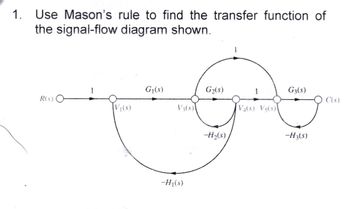
Follow the instructions. Kindly provide a COMPLETE and CLEAR solution. Answer it ASAP because I really need it right now. Answer should be typewritten.
Provide the following:
Step 1. Solve for k
Step 2. Solve for Tk (forward path gain)
Step 3. Identify the loop gains (TL)
Step 4. Identify the nontouching loops taken two at a time TNL(2 time)
Step 5. Identify the nontouching loops taken three at a time TNL(3 time)
Step 6. Identify the nontouching loops taken four at a time TNL(4 time)
Step 7. Solve for component ∆
Step 8. Solve for component ∆k (Note: We form ∆k by eliminating from ∆ the loop gains that touch the kth forward path)
Step 9. Substitute on the equation for transfer function

Step by stepSolved in 4 steps with 4 images

Can you redo this again? The answer should be typewritten, thanks.
Provide the following:
Step 1. Solve for k
Step 2. Solve for Tk (forward path gain)
Step 3. Identify the loop gains (TL)
Step 4. Identify the nontouching loops taken two at a time TNL(2 time)
Step 5. Identify the nontouching loops taken three at a time TNL(3 time)
Step 6. Identify the nontouching loops taken four at a time TNL(4 time)
Step 7. Solve for component ∆
Step 8. Solve for component ∆k (Note: We form ∆k by eliminating from ∆ the loop gains that touch the kth forward path)
Step 9. Substitute on the equation for transfer function
Can you redo this again? The answer should be typewritten, thanks.
Provide the following:
Step 1. Solve for k
Step 2. Solve for Tk (forward path gain)
Step 3. Identify the loop gains (TL)
Step 4. Identify the nontouching loops taken two at a time TNL(2 time)
Step 5. Identify the nontouching loops taken three at a time TNL(3 time)
Step 6. Identify the nontouching loops taken four at a time TNL(4 time)
Step 7. Solve for component ∆
Step 8. Solve for component ∆k (Note: We form ∆k by eliminating from ∆ the loop gains that touch the kth forward path)
Step 9. Substitute on the equation for transfer function
- please type so that i can read your solutionarrow_forwardI have four ESP-WROOM-32D boards, and four NRF24L01 modules. Each ESP-WROOM-32D board is connected to one NRF24L01 module. I want one NRF24L01 module to send a "Hello" message to the other three NRF24L01 modules at the same time. What is a good starter code in Arduino IDE?arrow_forwardWhat is serial in and parallel out?arrow_forward
- helparrow_forwardQuestion I. Synchronous Sequential Circuit hint) W issynchronized with C C Clock pulses), output z will he comel each time the value of the input signal w had not changed for 2 dak pulses . Out put value Change will appear at the clak Pul se with identical w values. Refer below. W: 00ll000ll011100 11|1II 0000 10110... Z: ool o10 100 100 100 1010000010000l... a. Circaits State table? b. State diagram? C. Use the birany Code to encode the State and set up the encoded State table. d. obtain minimnzed expresio ns for He next State and the output fanction .arrow_forwardQ2 C only thank youarrow_forward
 Introductory Circuit Analysis (13th Edition)Electrical EngineeringISBN:9780133923605Author:Robert L. BoylestadPublisher:PEARSON
Introductory Circuit Analysis (13th Edition)Electrical EngineeringISBN:9780133923605Author:Robert L. BoylestadPublisher:PEARSON Delmar's Standard Textbook Of ElectricityElectrical EngineeringISBN:9781337900348Author:Stephen L. HermanPublisher:Cengage Learning
Delmar's Standard Textbook Of ElectricityElectrical EngineeringISBN:9781337900348Author:Stephen L. HermanPublisher:Cengage Learning Programmable Logic ControllersElectrical EngineeringISBN:9780073373843Author:Frank D. PetruzellaPublisher:McGraw-Hill Education
Programmable Logic ControllersElectrical EngineeringISBN:9780073373843Author:Frank D. PetruzellaPublisher:McGraw-Hill Education Fundamentals of Electric CircuitsElectrical EngineeringISBN:9780078028229Author:Charles K Alexander, Matthew SadikuPublisher:McGraw-Hill Education
Fundamentals of Electric CircuitsElectrical EngineeringISBN:9780078028229Author:Charles K Alexander, Matthew SadikuPublisher:McGraw-Hill Education Electric Circuits. (11th Edition)Electrical EngineeringISBN:9780134746968Author:James W. Nilsson, Susan RiedelPublisher:PEARSON
Electric Circuits. (11th Edition)Electrical EngineeringISBN:9780134746968Author:James W. Nilsson, Susan RiedelPublisher:PEARSON Engineering ElectromagneticsElectrical EngineeringISBN:9780078028151Author:Hayt, William H. (william Hart), Jr, BUCK, John A.Publisher:Mcgraw-hill Education,
Engineering ElectromagneticsElectrical EngineeringISBN:9780078028151Author:Hayt, William H. (william Hart), Jr, BUCK, John A.Publisher:Mcgraw-hill Education,





